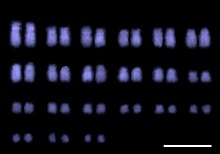
Molecular cytogenetics combines two disciplines, molecular biology and cytogenetics, and involves the analysis of chromosome structure to help distinguish normal and cancer-causing cells. Human cytogenetics began in 1956 when it was discovered that normal human cells contain 46 chromosomes. However, the first microscopic observations of chromosomes were reported by Arnold, Flemming, and Hansemann in the late 1800s. Their work was ignored for decades until the actual chromosome number in humans was discovered as 46. In 1879, Arnold examined sarcoma and carcinoma cells having very large nuclei. Today, the study of molecular cytogenetics can be useful in diagnosing and treating various malignancies such as hematological malignancies, brain tumors, and other precursors of cancer. The field is overall focused on studying the evolution of chromosomes, more specifically the number, structure, function, and origin of chromosome abnormalities.[1][2] It includes a series of techniques referred to as fluorescence in situ hybridization, or FISH, in which DNA probes are labeled with different colored fluorescent tags to visualize one or more specific regions of the genome. Introduced in the 1980s, FISH uses probes with complementary base sequences to locate the presence or absence of the specific DNA regions. FISH can either be performed as a direct approach to metaphase chromosomes or interphase nuclei. Alternatively, an indirect approach can be taken in which the entire genome can be assessed for copy number changes using virtual karyotyping. Virtual karyotypes are generated from arrays made of thousands to millions of probes, and computational tools are used to recreate the genome in silico.
- ^ Kearney L, Horsley SW (September 2005). "Molecular cytogenetics in haematological malignancy: current technology and future prospects". Chromosoma. 114 (4): 286–94. doi:10.1007/s00412-005-0002-z. PMID 16003502. S2CID 19251871.
- ^ Bigner SH, Schröck E (November 1997). "Molecular cytogenetics of brain tumors". Journal of Neuropathology and Experimental Neurology. 56 (11): 1173–81. doi:10.1097/00005072-199711000-00001. PMID 9370227.
© MMXXIII Rich X Search. We shall prevail. All rights reserved. Rich X Search
